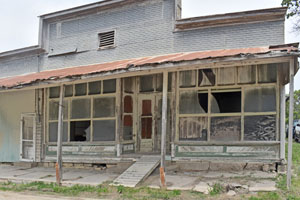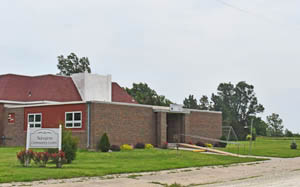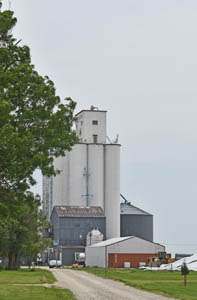
Grain elevator and agriculture buildings in Navarre, Kansas, courtesy of Google Maps.
Navarre, Kansas, an unincorporated community in Logan Township of Dickinson County, is an extinct town today.
It started in 1869 when church followers organized the German Baptist Brethren Church southeast of Abilene.
In 1880, the District 13 Prairie Center School District was established, and a school was built one-half mile east of town. Joseph Billings, B.B. Kesdinger, and A.K. Bassler were the first board members.
A post office was established on February 7, 1884.
Elder P.R. Wrightsman platted the town in 1887. The Atchison, Topeka & Santa Fe Railroad first came through Navarre the same year. This branch started at Neva, three miles west of Strong City, came through Navarre, and went to Superior, Nebraska. In addition to hauling freight, passengers could pay a small fee to ride the train to surrounding areas. The depot was located south of the crossing of Main Street.
In 1889, Elder P.R. Wrightsman was able to solicit the funds to build the new Brethren Church in the city limits of Navarre.
Chris Hoffman of Enterprise, Kansas, established Navarre’s first grain elevator in 1901. Later, two elevators were established in the town, along the railroad tracks on the south side of Main Street.
The school was moved into town on July 20, 1901, from one-half mile east of town.
A Methodist church was built on the north side of Main Street in 1910. Its ministers came from the surrounding towns of Hope and Woodbine. That year, Navarre sported a grain elevator, a creamery, a general store, telegraph and express offices, a money order post office, and a population of 75.
A new school was built in 1914.
Navarre became a third-class city in 1915. This was due to large shipments of butter from the Ira Kaffman Creamery, the baby chick shipments from Lenhert Hatchery, and the large influx of Mexican workers on the Santa Fe railroad. It remained a third-class city until 1930.
The Brethren Church burned down in 1917 and was replaced by another building near the present-day cemetery on the west side of town, south of Main Street. It no longer stands today.
From 1924 to 1926, high school classes were held in the Methodist church basement.
In 1927, the Navarre Hotel and the telephone building burned down.
The school burned down in 1929. Afterward, classes were held in the Brethren Church.
In the late hours of October 28, 1939, flames were seen coming from the Helstab Hardware store. Area residents said they had heard a dull explosion shortly before the blaze was discovered. Navarre had no water supply then, so firefighters formed bucket brigades to put out the fire. The firefighting force consisted of volunteers from neighboring towns and farmers from the surrounding area. In addition to the hardware store, the Hussey lumberyard, the Larsen Creamery, and the Larsen home were destroyed in the blaze. The town hall, which had been used for plays, meetings, and social gatherings, was on the second floor of the hardware store, so it, too, was gone. None of these buildings were ever rebuilt.
Navarre’s post office closed on September 3, 1971. Though its closing officially made Navarre an “extinct town,” the community continued at a slower pace.
Today, the Burlington Northern Santa Fe Railroad runs through the town beside the grain elevator. Several agricultural buildings can be found here. As of the 2020 census, Navarre’s population was 52. A few old business buildings, several homes, and a community center in the old school building serve the residents.
The community is served by Chapman’s USD 473 public school district.
Navarre is about 12 miles southeast of Abilene.
©Kathy Alexander/Legends of Kansas, updated 2024.
Also See:
Dickinson County Extinct Towns
Dickinson County Photo Gallery
Sources:
Blackmar, Frank W.; Kansas: A Cyclopedia of State History, Vol I; Standard Publishing Company, Chicago, IL 1912.
Coup, Adam; “Navarre, Dickinson County,” Lost Kansas Communities, Kansas State University, 2012.
Oraik, Elmer Le Roy; A History of the Church of the Brethren in Kansas, 1922.
Wikipedia






